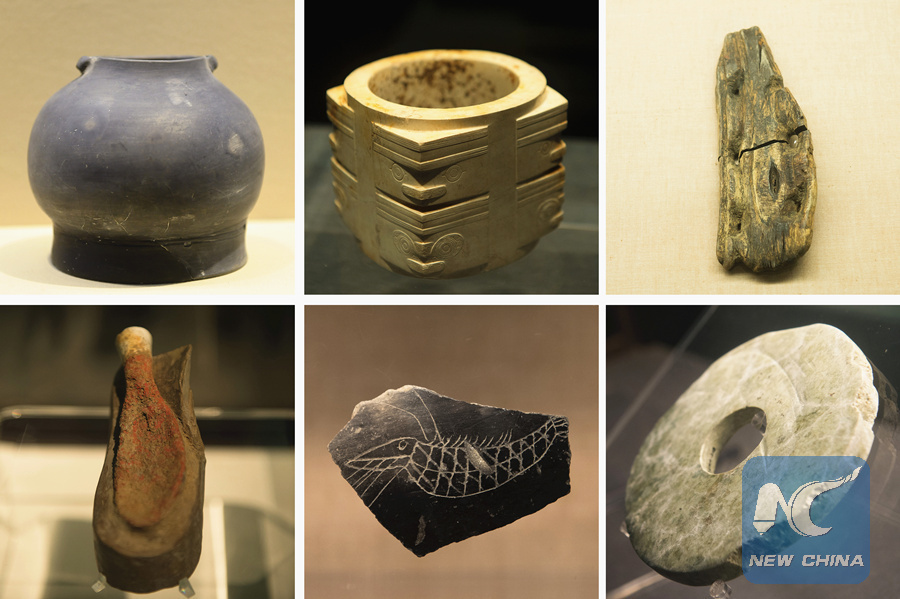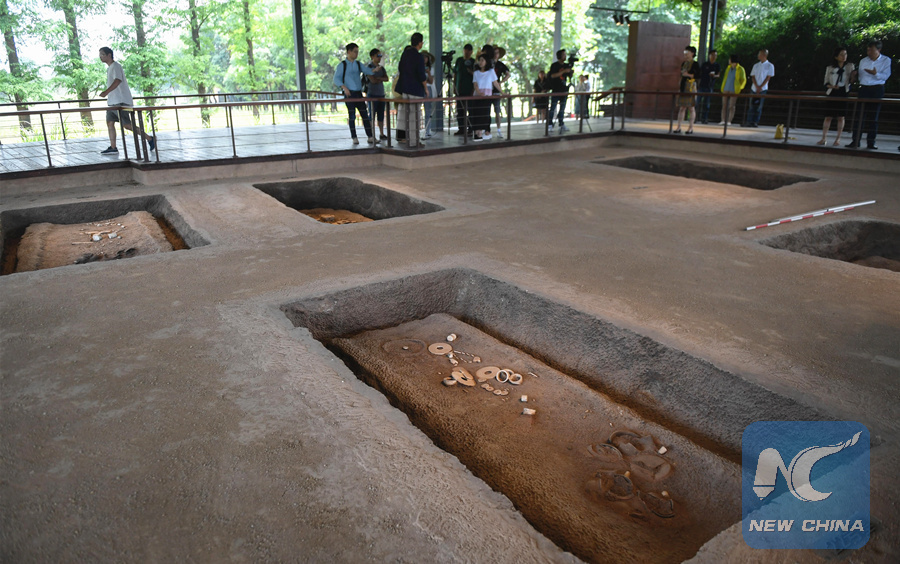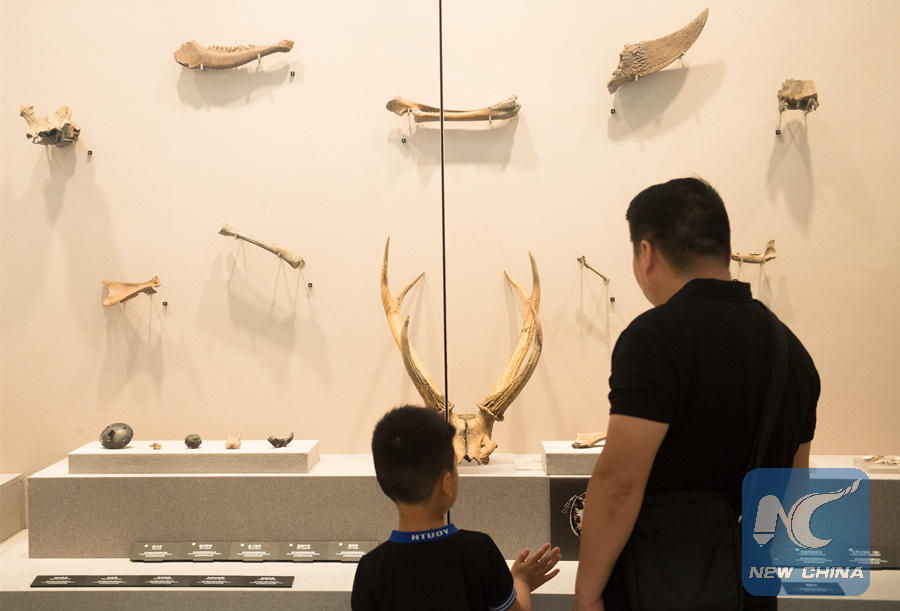
Combo photo shows artifacts excavated from the Liangzhu relic site in Hangzhou, capital of east China's Zhejiang Province. (Xinhua/Weng Xinyang)
BAKU, July 6 (Xinhua) -- China's Archaeological Ruins of Liangzhu City were on Saturday inscribed on the UNESCO World Heritage List as a cultural site, bringing the total number of the Asian country's sites on the list to 55.
International delegates congratulated China on the world's recognition of the exceptional site as a concrete testimony of 5,000 years of Chinese civilization and its unique contribution to world civilization.
Meanwhile, they praised China's notable performance in the conservation of its world heritages and expressed readiness for strengthened international cooperation in the protection and management of the world heritages.

Photo taken on June 23, 2019 shows tombs at Liangzhu relic site in Hangzhou, capital of east China's Zhejiang Province. (Xinhua/Huang Zongzhi)
CULTURAL TREASURE OF CHINA
The decision to add the Chinese cultural site, located in the eastern Chinese city of Hangzhou, to the United Nations Educational, Scientific and Cultural Organization's (UNESCO) World Heritage List was approved by the World Heritage Committee at its ongoing 43rd session in the Azerbaijani capital of Baku.
"It is considered to be a supreme achievement of prehistoric rice-cultivating civilization of China and East Asia over 5,000 years ago and an outstanding example of early urban civilization," said a report by the International Council on Monuments and Sites (ICOMOS), the committee's official advisory body.
Sitting on a plain crossed by river networks in the Yangtze River Basin, the nominated property of Archaeological Ruins of Liangzhu City includes the archaeological remains of Liangzhu City (3300 B.C.-2300 B.C.), which was once the center of power and belief of an early regional state in the lower reaches of the Yangtze River during the Late Neolithic China period.
The property testifies to the existence of a regional state with a unified belief system and supported by a rice-cultivating agriculture in late Neolithic China. It also represents an early urban civilization with complex functions and structures.
"Archaeological Ruins of Liangzhu City is a major archaeological discovery of China in the 20th century and an important cultural site that witnessed the 5,000-year civilization of the country," said Liu Yuzhu, head of China's National Cultural Heritage Administration, at the committee session.
"We are proud that after 25 years of preparation, our efforts have finally led to the successful inscription of this exceptionally important property, which is the most concrete testimony of 5,000 years of Chinese civilization," said Shen Yang, ambassador and permanent delegate of China to UNESCO, following the announcement of the decision.
"We are keenly aware that the inscription also entails an enormous responsibility for conserving this heritage of humanity," he added.
Zhou Jiangyong, Hangzhou's municipal committee secretary of the Communist Party of China, said the Chinese city will spare no effort to "protect and make proper use of the enormous cultural heritage before passing it on to the future generations."
The Chinese side also pledged continued efforts and strengthened international cooperation in the protection and management of world heritages in China.

People look at excavated animal bones at Liangzhu Museum in Hangzhou, capital of east China's Zhejiang Province, June 22, 2019. (Xinhua/Weng Xinyang)
PERMANENT HERITAGE FOR WORLD
Attendants at the convention congratulated China on the inscription, commenting on the site's cultural and historic value as well as its contribution to world civilization.
"We see it as an important heritage site taking into account its historical value and also its contribution to the civilization of mankind, in particular for China, as well as the rest of the world. We are really seeing a great heritage coming to enrich the list of human civilization," said Edmond Moukala, chief of the Africa Unit of the World Heritage Center.
Moukala highlighted Liangzhu's universal value, especially in boosting tourism and providing a rich variety of research resources for scholars around the world who are interested in the Liangzhu culture.
He noted that China has been doing an excellent job in protecting its world heritages, which sets a "good example for the rest of the world."
"We think that Liangzhu will also be an inspiring case study that will help us not only to learn about how to preserve heritages, but also learn how heritages can really provide expertise to our African people. We look forward to collaborating with China and to learning from you," Moukala said.
Similarly, Anar Karimov, Azerbaijan's ambassador and permanent delegate to UNESCO, also praised the efforts of the Chinese government and the "overall Chinese perception and vision" to protect heritages for the younger generations.
"We commend the efforts of China and Chinese experts in protecting their heritages. Also, we see the dedication and commitment of local Chinese authorities and Chinese communities to protect and conserve the heritage of Liangzhu and (other heritages) all over the country," Karimov said.
He also expressed the hope that China would share its experience in protecting world heritages with Azerbaijan.
"We, Azerbaijan, as a young country with relatively less experts and capacity in this field, think that there is much to be learned from our Chinese friends. This is another area where Azerbaijan is willing to work and cooperate with our Chinese partners," he said.
On Friday, China's Migratory Bird Sanctuaries along the Coast of the Yellow Sea-Bohai Gulf (Phase I) was also inscribed on the World Heritage List as a natural site.
The natural site is located in the Yellow Sea ecoregion, containing the world's largest continuous mudflat seashore.
It is the central node of the East Asian-Australasian Flyway (EAAF), which is the most threatened migratory flyway worldwide and boasts the largest number of endangered and critically endangered species.
The area has a high biodiversity, with about 280 species of fishes and more than 500 species of invertebrates, providing a variety of food resources for millions of migratory birds.
At present, China has 55 world heritage sites, including 37 cultural sites, 14 natural sites and four cultural and natural heritages.

